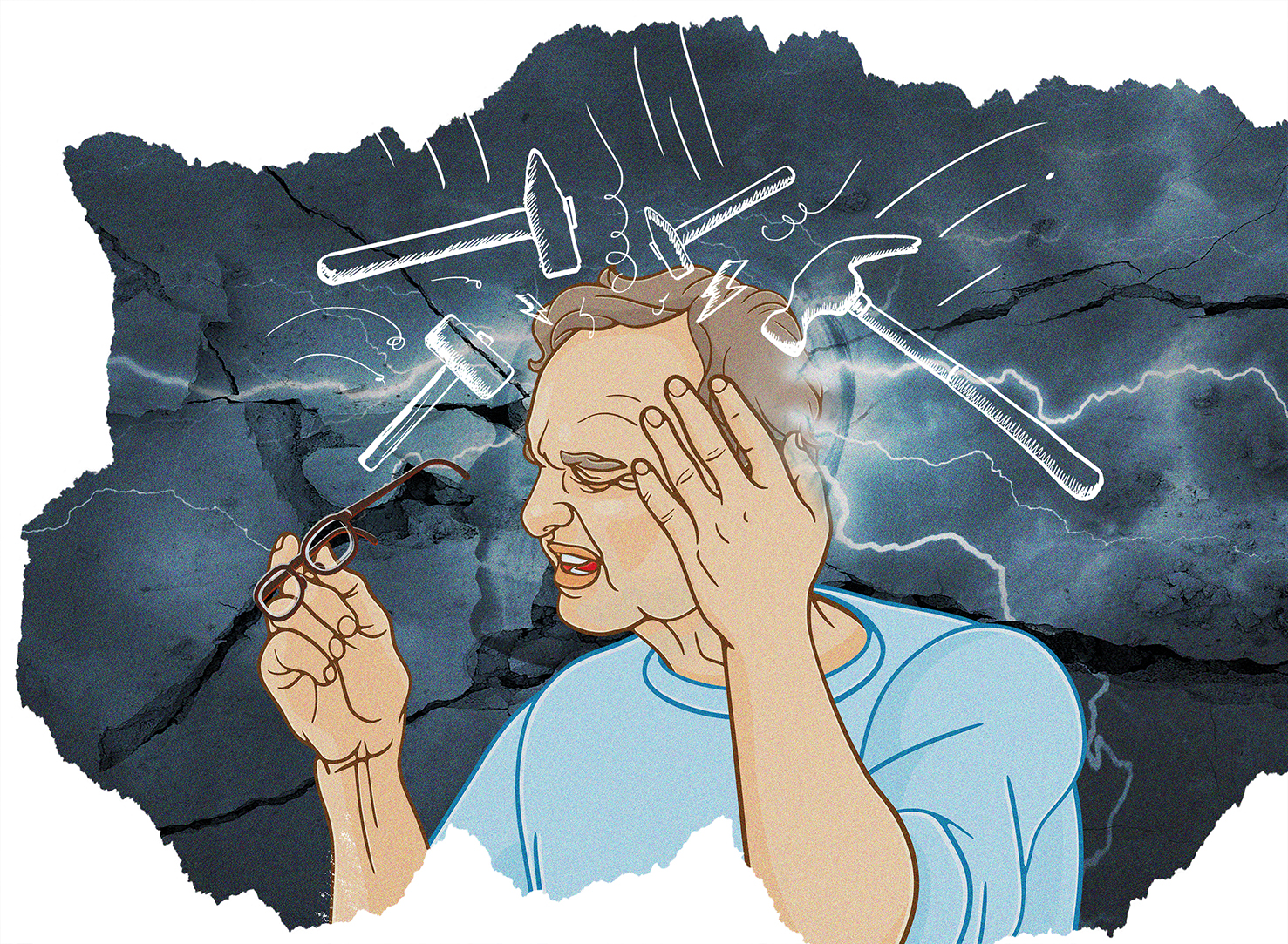
Giant cell arteritis (GCA), also known as temporal arteritis is a chronic inflammatory vasculitis that predominately affects large- and medium-sized arteries in individuals above the age of 50. More notably, GCA affects the cranial branches of the carotid arteries and the granulomatous nature of GCA contributes to the formation of vessel aneurysms1. In addition, untreated GCA may also lead to blindness, aortitis and stroke2. Not surprisingly, the highest incidence of GCA is reported in the Northern Europe and the lowest in Asia-Pacific2. Traditionally, patients with GCA are treated with a high dose of corticosteroids, but since corticosteroids are associated with significant side effects3, the treatment unmet needs persist in patients with GCA until recently.
Giant Cell Arteritis: A Silent Predator
GCA is a medium and large-vessel vasculitis, which is an important cause of secondary headache in older adults ≥ the age of 50. While GCA has a classic presentation, atypical presentation such as fever of unknown origin, cough, low or normal erythrocyte sedimentation rate [ESR]) may lead to a delay in diagnosis4. Interestingly, the primary vascular targets of GCA are extracranial branches of the external and internal carotid arteries which results in headaches, scalp tenderness and jaw claudication. If left untreated, it may potentially lead to blinding ischaemic injury to the optic nerve or retina5. In fact, at least 9% of patients experience severe, irreversible vision loss from the disease, a complication that is more likely if high dose corticosteroid are not started early5. To assist the diagnosis of GCA, the 2022 American College of Rheumatology (ACR) and the European Alliance of Associations for Rheumatology (EULAR) provided a classification criterion for GCA with an 87% sensitivity and 94.8% specificity (Figure 1)6.

Figure 1. The final 2022 American College of Rheumatology/EULAR classification criteria for GCA6. EULAR= European Alliance of Associations for Rheumatology, GCA= giant cell arteritis. ESR= erythrocyte sedimentation rate; FDG-PET= fluorodeoxyglucose-18-positron emission tomography.
However, temporal artery biopsy (TAB) remains the gold standard for the diagnosis of GCA and should be performed within 2 weeks of initiation of corticosteroids. What is the optimum time for obtaining a TAB in a patient suspected of GCA and is it necessary?
A study by Papadakos et al., (2023) analysed data from 109 patients with a median age of 76 years and a median time from glucocorticoid treatment to TAB of 4 days. Interestingly, 60% of biopsies were positive and the study suggested that steroid treatment for more than 7 days was independently linked with lower rates of positive TAB (adjusted odds ratio, 0.33; 95% confidence interval [CI], 0.11-1.00). What does this mean? This study demonstrated that glucocorticoid (GC) treatment may affect the results of TAB, especially if the biopsy is taken after 7 days7. But should patients suspected of GCA be treated with high or low dose of corticosteroids? The answer to this is often complicated since corticosteroids are often used as a mainstay treatment, however the type, dose, route and duration of corticosteroid still remains controversial. A study by Kanakamedala et al., (2021) surveyed neuro-ophthalmologists to determine the commonly prescribed dosage of corticosteroids for the treatment of GCA with or without visual loss. Remarkably, the study supported for conventional recommendations for high dose intravenous corticosteroid for GCA with visual loss and lower dose of oral regimens for GCA without visual loss (Figure 2)8.

Figure 2. Survey questions on dosage of corticosteroid used in patient with giant cell arteritis with acute visual loss8. IV= intravenous;
kg= kilograms; mg= milligrams.
A Breath of Fresh Air with Janus Kinase (JAK) inhibitors
Treatment for GCA has been limited and in the past since corticosteroids were the main treatment option. Nevertheless, recent studies have supported the use of JAK inhibitors (JAKi) since inflammatory markers such as interleukin-6 (IL-6) and interferon gamma (IFN-γ) have strongly been implicated in the pathogenesis of GCA9. One of the upcoming potential agents is the upadacitinib (UPA), an oral and selective JAKi with multiple clinical indications and a strong inhibitory effects on IL-6 and IFN-γ. A double-blind, randomised placebo-controlled phase 3 trial conducted in 24 countries, consisting of two 52 weeks period evaluated the efficacy and safety of UPA with placebo in combination with GCs taper regimen in patients with GCA. The study included 428 patients randomised to receive either UPA 7.5 mg (UPA7.5 [n=107]) or UPA 15 mg (UPA15 [n=209]) or placebo (PBO [n=112]). The primary endpoint was sustained remission, defined as the absence of signs or symptoms of GCA from week 12 through week 52 and adherence to the protocol-defined GC taper regimen. Secondary endpoint included sustained complete remission (defined as achievement of sustained remission with normalised ESR and c-reactive protein [CRP]), disease flare-related endpoints and several patient-reported outcomes including the functional assessment of chronic illness therapy (FACIT)-Fatigue (a 40-item measure that assesses self-reported fatigue and its impact upon daily activities and function), and cumulative GC exposure9.
Remarkably, the primary endpoint of sustained remission at week 52 was achieved in UPA15 group compared PBO group (46% vs 29%, p=0.0019). In addition, the study met 9 out of 11 multiplicity-controlled secondary endpoints with UPA15 including achievement of sustained complete remission from week 12 throughout week 52 (37% vs 16%, p<0.0001)9. Furthermore, UPA15 also reduced the risk of flare ups of GCA throughout the 52 weeks compared to those receiving PBO (Figure 3),

Figure 3. Kaplan-Meier Curves for Time to First Disease Flare Through Week 52. Patients who never met the “flare-free” criteria required prior to the assessment of disease flare were considered to have flare at baseline. Patients who met the “flare-free” criteria but did not have flares were censored at the last assessment prior to week 529. GCA= giant cell arteritis, GC-T= glucocorticoid taper, NE= not estimable, PBO= placebo, UPA= upadacitinib
as well as significantly improved the FACIT-Fatigue scores from baseline to week 52 (p=0.0036). However, even though UPA7.5 showed numerically better efficacy compared to placebo, the results were not as promising as those seen with UPA15. A salient point to note was the safety outcome related to UPA groups which were relatively comparative to PBO group, however, there were a higher rate of serious infection and major adverse cardiovascular events (MACEs) observed in PBO group with no MACEs reported in UPA groups. Here, the study highlighted the superior efficacy of UPA 15 mg in GCA when combined with a 26-week of GC taper dose, in addition to reducing the GC reliance when compared to placebo without causing any new safety signal concerns9. In light of these findings, we may conclude that the UPA 15 mg represents a potential new oral targeted therapy for patients with GCA, however, UPA is currently not an approved treatment for GCA and is awaiting for food and drug administration (FDA) approval.
References
1. Ameer MA, StatPearls Publishing LLC.; 2024. 2. Ing EB, et al. Longhua Chinese Medicine 2021; 4. 3. Wilson JC, et al. Semin Arthritis Rheum 2017; 46(6): 819-27. 4. Smith JH, et al. Headache: The Journal of Head and Face Pain 2014; 54(8): 1273-89. 5. Dinkin M, et al. Curr Treat Options Neurol 2021; 23(2): 6. 6. Ponte C, et al. Annals of the Rheumatic Diseases 2022; 81(12): 1647-53. 7. Papadakos SP, et al. J Clin Rheumatol 2023; 29(4): 173-6. 8. Kanakamedala A, et al. Neuroophthalmology 2021; 45(1): 17-22. 9. Blockmans D, et al. Annals of the Rheumatic Diseases 2024; 83(Suppl 1): 232-3.





